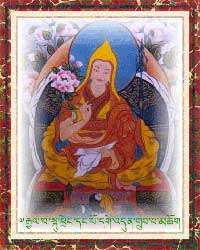1st Dalai Lama
| Gendun Drup | |
|---|---|
| 1st Dalai Lama (posthumous designation) | |
 དགེ་འདུན་གྲུབ་པ། | |
| Reign | N/A |
| Successor | Gendün Gyatso |
| Tibetan | དགེ་འདུན་གྲུབ་པ། |
| Wylie | dge ’dun grub pa |
| Pronunciation | [kẽ̀tyn tʂʰùppa] |
| Transcription (PRC) | Gêdün Chubba |
| THDL | Gendün Druppa |
| Father | Gonpo Dorje |
| Mother | Jomo Namkha Kyi |
| Born |
1391 Shabtod, Ü-Tsang, Tibet |
| Died |
1474 (aged 82–83) Tibet |
| Part of a series on |
| Tibetan Buddhism |
|---|
 |
|
Practices and attainment |
|
History and overview |
|
Gendün Druppa (Tibetan: དགེ་འདུན་གྲུབ་པ།, Wylie: dge 'dun grub pa , 1391–1474) was considered posthumously to be the 1st Dalai Lama.[1]
Biography
Gendün Druppa was born in a cowshed in Gyurmey Rupa near Sakya in the Tsang region of central Tibet, the son of Gonpo Dorje and Jomo Namkha Kyi, nomadic tribespeople.[2] He was raised as a shepherd until the age of seven. His birth name (according to the Tibetan Buddhist Resource Center, his personal name) was Péma Dorje (Tibetan: པད་མ་རྡོ་རྗེ་ , "Vajra Lotus"). Later he was placed in Narthang Monastery. In 1405, he took his śrāmaṇera (novitiate) vows from the abbot of Narthang, Khenchen Drupa Sherap.
When he was 20 years old, in about 1411, he received the name Gendün Druppa upon taking the vows of a bhikṣu (monk) from the abbot of Narthang Monastery.[3] Also at this age he became a student of the scholar and reformer Je Tsongkhapa (1357–1419),[4] who some say was his uncle.[5] Around this time he also became the first abbot of Ganden Monastery, founded by Tsongkhapa himself in 1409.[6] By the middle of his life, Gendün Druppa had become one of the most esteemed scholar-saints in the country.
Tradition states that Palden Lhamo, the female guardian spirit of the sacred lake, Lhamo La-tso, promised the First Dalai Lama in one of his visions "...that she would protect the reincarnation lineage of the Dalai Lamas." Since the time of Gendün Gyatso, who formalized the system, monks have gone to the lake to meditate when seeking visions with guidance on finding the next reincarnation.[7]
Gendün Druppa founded the major monastery of Tashilhunpo at Shigatse, which later became the seat of the Panchen Lamas.[8]
Gendün Druppa had no political power. It was in the hands of viceroys such as the Sakyas, the prince of Tsang, and the Mongolian Khagan. The political role of the Dalai Lamas only began with the reign of the 5th Dalai Lama.
He remained the abbot of Tashilhunpo Monastery until he died while meditating in 1474 at the age of 84 (83 by Western reckoning).[5]
The Samding Dorje Phagmo (1422–1455), the highest female incarnation in Tibet,[9] was a contemporary of Gendun Drüppa. Her teacher, the Bodongpa Panchen Chogley Namgyal was also one of his teachers; he received many teachings and empowerments from him.[10]
Some of the most famous texts Gendün Druppa wrote were:
- Sunlight on the Path to Freedom, a commentary on Abhidharma-kosa
- Crushing the Forces of Evil to Dust, an epic poem on the life and liberating deeds of Gautama Buddha
- Song of the Eastern Snow Mountain, a poem dedicated to Je Tsongkhapa
- Praise of the Venerable Lady Khadiravani Tara, an homage to Tara
Notes
- ↑ "dge 'dun grub pa". Tibetan Buddhist Resource Center. Retrieved 20 May 2015.
- ↑ Gedun Drupa at Dalai Lama website.
- ↑ Thubten Samphel and Tendar (2004), p. 75.
- ↑ Farrer-Halls, Gill. World of the Dalai Lama. Quest Books: 1998. p. 77
- 1 2 Thubten Samphel and Tendar (2004), p.35.
- ↑ Simhanada, The Lion's Roar of Mahayana Buddhism.
- ↑ Laird, Thomas (2006). The Story of Tibet: Conversations with the Dalai Lama, pp. 139, 264-265. Grove Press, N.Y. ISBN 978-0-8021-1827-1
- ↑ Chö Yang: The Voice of Tibetan Religion and Culture. (1991) Year of Tibet Edition, p. 79. Gangchen Kyishong, Dharmasala, H.P., India.
- ↑ The Power-places of Central Tibet: The Pilgrim's Guide, (1988) p. 268. Keith Dowman. ISBN 0-7102-1370-0.
- ↑ "Bodong.info". Archived from the original on 2009-05-13. Retrieved 2009-03-07.
References
- Thubten Samphel and Tendar (2004). The Dalai Lamas of Tibet. Roli & Janssen, New Delhi. (2004). ISBN 81-7436-085-9
- McKay, A. (editor) (2003): History of Tibet. Publisher: RoutledgeCurzon. ISBN 0-7007-1508-8
Further reading
- Mullin, Glenn H. (2001). The Fourteen Dalai Lamas: A Sacred Legacy of Reincarnation, pp. 50–85. Clear Light Publishers. Santa Fe, New Mexico. ISBN 1-57416-092-3.
- Selected Works of the Dalai Lama I by Anne Kandt, Christine Cox, Dalai Lama Dge-Dun-Grub I, Glenn H. Mullin, Sidney Piburn (1985)
External links
| Buddhist titles | ||
|---|---|---|
| Preceded by New creation |
Dalai Lama N/A Posthumously recognized |
Succeeded by Gendun Gyatso |